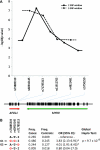APOL1 variants increase risk for FSGS and HIVAN but not IgA nephropathy
- PMID: 21997397
- PMCID: PMC3231781
- DOI: 10.1681/ASN.2011040434
APOL1 variants increase risk for FSGS and HIVAN but not IgA nephropathy
Abstract
A chromosome 22q13 locus strongly associates with increased risk for idiopathic focal segmental glomerulosclerosis (FSGS), HIV-1-associated nephropathy (HIVAN), and hypertensive ESRD among individuals of African descent. Although initial studies implicated MYH9, more recent analyses localized the strongest association within the neighboring APOL1 gene. In this replication study, we examined the six top-most associated variants in APOL1 and MYH9 in an independent cohort of African Americans with various nephropathies (44 with FSGS, 21 with HIVAN, 32 with IgA nephropathy, and 74 healthy controls). All six variants associated with FSGS and HIVAN (additive ORs, 1.8 to 3.0; P values 3 × 10(-2) to 5 × 10(-5)) but not with IgA nephropathy. In conditional and haplotype analyses, two APOL1 haplotypes accounted for virtually all of the association with FSGS and HIVAN on chromosome 22q13 (haplotype P value = 5.6 × 10(-8)). To assess the role of MYH9 deficiency in nephropathy, we crossbred Myh9-haploinsufficient mice (Myh9(+/-)) with HIV-1 transgenic mice. Myh9(+/-) mice were healthy and did not demonstrate overt proteinuria or nephropathy, irrespective of the presence of the HIV-1 transgene. These data further support the strong association of genetic variants in APOL1 with susceptibility to FSGS and HIVAN among African Americans.
Figures


Comment in
-
Apolipoprotein l1 and the genetic basis for racial disparity in chronic kidney disease.J Am Soc Nephrol. 2011 Nov;22(11):1955-8. doi: 10.1681/ASN.2011090932. Epub 2011 Oct 13. J Am Soc Nephrol. 2011. PMID: 21997393 No abstract available.
References
-
- Kiberd BA, Clase CM: Cumulative risk for developing end-stage renal disease in the US population. J Am Soc Nephrol 13: 1635–1644, 2002 - PubMed
-
- Tucker JK: Focal segmental glomerulosclerosis in African Americans. Am J Med Sci 323: 90–93, 2002 - PubMed
-
- Kiryluk K, Martino J, Gharavi AG: Genetic susceptibility, HIV infection, and the kidney. Clin J Am Soc Nephrol 2[Suppl 1]: S25–S35, 2007 - PubMed
-
- Papeta N, Sterken R, Kiryluk K, Kalyesubula R, Gharavi AG: The molecular pathogenesis of HIV-1 associated nephropathy: Recent advances. J Mol Med 89: 429–436, 2011 - PubMed
-
- Wyatt CM, Klotman PE: HIV-associated nephropathy in the era of antiretroviral therapy. Am J Med 120: 488–492, 2007 - PubMed
Publication types
MeSH terms
Substances
Grants and funding
LinkOut - more resources
Full Text Sources
Other Literature Sources
Miscellaneous

